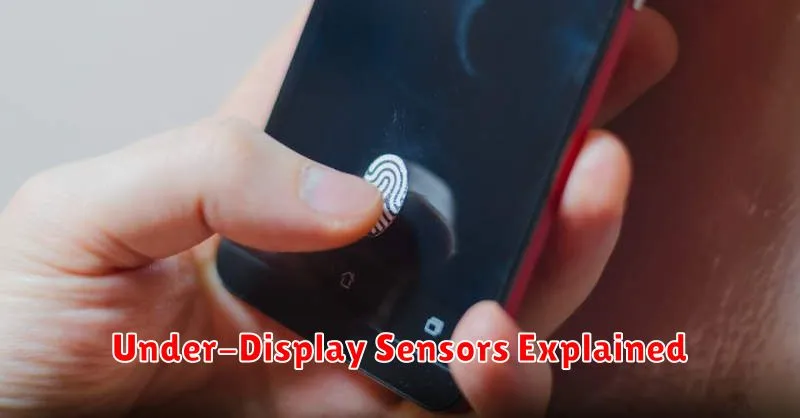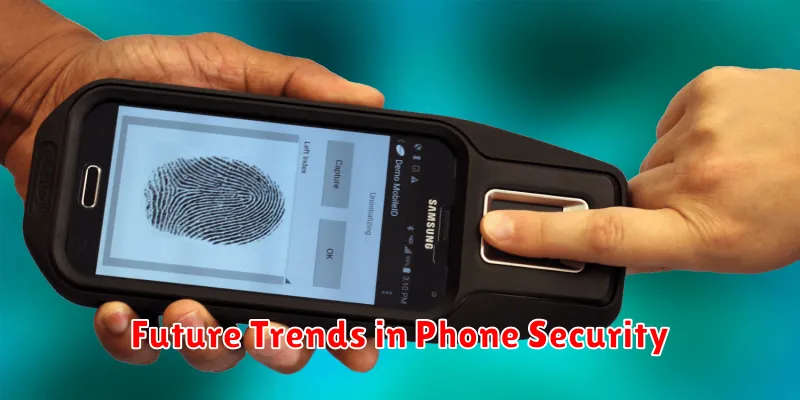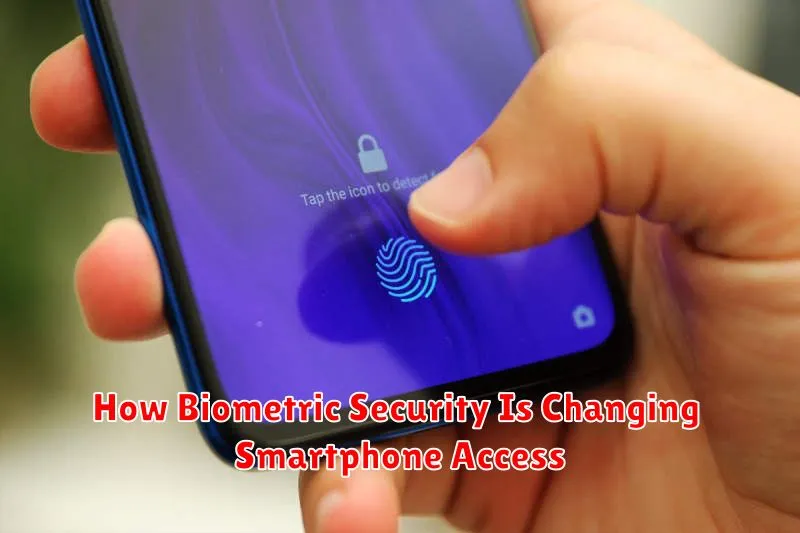In today’s rapidly evolving digital landscape, biometric security is revolutionizing how we access our smartphones. Gone are the days of easily forgotten PINs and vulnerable patterns. Biometric authentication methods, such as fingerprint scanning, facial recognition, and iris scanning, offer a more secure and convenient way to protect our personal data and ensure that only authorized users can access our devices. This enhanced security is essential given the increasing amount of sensitive information we store on our smartphones, from financial details to private conversations. Biometrics provide a robust layer of protection against unauthorized access, making it significantly more difficult for thieves or hackers to gain entry.
This article explores the various ways biometric security is transforming smartphone access. We’ll delve into the different types of biometric technologies available, examine their advantages and disadvantages, and consider the future implications of this rapidly advancing field. Understanding the power and potential of biometrics is crucial for anyone seeking to enhance their smartphone security in an increasingly interconnected world. From the convenience of fingerprint unlocking to the advanced security of iris scanning, we will uncover the key features and benefits of biometric authentication on smartphones.
What Is Biometric Security?
Biometric security uses unique biological traits to verify and authenticate individuals. It relies on measurable, distinctive physical or behavioral characteristics to recognize and grant access. Authentication is at the heart of biometric security, ensuring only authorized users access sensitive data or systems.
Physiological biometrics focus on physical attributes. Common examples include fingerprints, facial recognition, and iris scanning. These methods rely on the unchanging nature of these traits. Behavioral biometrics, on the other hand, analyze patterns in human activity. Examples include voice recognition, gait analysis, and typing rhythm. These patterns, while unique, can be influenced by external factors.
Fingerprint Scanners in Smartphones
Fingerprint scanners have become a ubiquitous feature in modern smartphones, offering a convenient and secure way to unlock devices and authenticate users. These scanners utilize biometric technology to identify the unique ridge patterns of an individual’s fingerprint.
Several types of fingerprint scanning technologies exist, including capacitive, optical, and ultrasonic sensors. Capacitive sensors are the most common, using tiny capacitors to measure the electrical differences between the ridges and valleys of a fingerprint. Optical sensors, on the other hand, take a picture of the fingerprint and analyze the image. Ultrasonic sensors use high-frequency sound waves to create a 3D map of the fingerprint, providing increased accuracy and security.
The integration of fingerprint scanners into smartphones has significantly enhanced security, replacing less secure methods such as PINs and patterns. They offer quick and reliable authentication for various tasks beyond unlocking the device, including mobile payments and app access.
Face Recognition Technology
Face recognition is a biometric technology that uses distinctive facial features to identify and authenticate individuals. It works by analyzing unique patterns in a person’s face, such as the distance between the eyes, the shape of the nose, and the contours of the jawline. This data is then converted into a digital representation, called a faceprint.
When a user attempts to unlock their device using face recognition, the system captures a live image of their face and compares it to the stored faceprint. If the two images match with a sufficient degree of accuracy, the device is unlocked. Modern smartphones often utilize sophisticated 3D mapping techniques to enhance security and prevent spoofing attempts using photographs or masks.
Under-Display Sensors Explained

Under-display sensors represent a significant advancement in biometric technology, seamlessly integrating fingerprint scanners and other sensors beneath the display surface. This allows for a larger screen-to-body ratio and a cleaner aesthetic, eliminating the need for physical buttons or rear-mounted sensors.
There are two primary types of under-display sensors: optical and ultrasonic. Optical sensors illuminate the fingertip and capture a 2D image, while ultrasonic sensors use high-frequency sound waves to create a 3D map of the fingerprint. This difference results in varying levels of security and performance. Generally, ultrasonic sensors are considered more secure due to their 3D mapping capability.
The technology continues to evolve, addressing challenges such as screen protector compatibility and performance in various lighting conditions. Under-display sensors are becoming increasingly prevalent in modern smartphones, signifying a shift towards more integrated and streamlined biometric authentication.
Security vs Convenience Debate
The integration of biometric security into smartphones has sparked a debate centered around the trade-off between security and convenience. While biometrics, such as fingerprint scanning and facial recognition, offer a streamlined login experience, questions surrounding their vulnerability remain. Traditional methods like passwords, while arguably less convenient, provide a layer of security that isn’t inherently tied to a physical attribute.
Security concerns with biometrics include the potential for spoofing and the permanence of compromised biometric data. Unlike passwords, which can be changed, a compromised fingerprint or facial scan cannot be easily replaced. This raises privacy implications, particularly regarding data storage and potential misuse.
AI in Biometric Verification
Artificial intelligence plays a crucial role in enhancing biometric verification systems. AI algorithms, particularly machine learning, are used to improve the accuracy and security of these systems.
AI can address challenges like spoofing attempts by analyzing subtle details and patterns in biometric data that are often imperceptible to humans. This leads to more robust and reliable authentication.
Furthermore, AI can adapt to changes in a user’s biometric data over time, such as aging or minor injuries, ensuring consistent performance and reducing the need for frequent re-enrollment.
Biometric Data and Privacy
The increasing use of biometric authentication raises important privacy considerations. How is this sensitive data collected, stored, and protected? Unlike passwords, biometric data cannot be easily changed if compromised. This makes robust security measures absolutely essential.
Data breaches are a significant concern. If biometric data is stolen, the potential for misuse is considerable. Furthermore, the permanence of biometric data presents unique challenges. Once compromised, an individual’s fingerprint or facial scan could be exploited indefinitely. This highlights the need for strong encryption and secure storage protocols.
Who has access to this data, and for what purposes is it used? These are crucial questions that users should consider. Transparency from manufacturers and app developers regarding data collection and usage policies is vital for building and maintaining trust.
Multi-Factor Authentication
Multi-factor authentication (MFA) adds layers of security beyond a single password. It requires users to present multiple pieces of evidence from different categories to verify their identity. These categories typically include something you know (like a password or PIN), something you have (such as a security token or smartphone), and something you are (biometrics like a fingerprint or facial scan).
MFA significantly strengthens security by making it much harder for unauthorized individuals to access accounts, even if they manage to compromise one factor, like a password. By requiring multiple factors, MFA effectively blocks many common attack vectors.
Comparing Security Methods
Traditional smartphone security measures like PINs and passwords are susceptible to vulnerabilities such as forgetting, guessing, or shoulder surfing. Pattern locks, while convenient, offer limited security due to predictable patterns and smudge trails on the screen.
Biometric security methods offer a more robust alternative. Fingerprint scanning provides a convenient and relatively secure method, but can be susceptible to spoofing using high-quality replicas. Facial recognition adds another layer of security, being more difficult to bypass, though it can be affected by lighting conditions and accessories.
Iris scanning is considered the most secure biometric method due to the unique complexity of iris patterns. However, user convenience can be a challenge due to precise alignment requirements during the scanning process.
Future Trends in Phone Security

Beyond current biometric methods like fingerprint and facial recognition, the future of phone security points towards more sophisticated and integrated solutions. Behavioral biometrics will likely play a larger role, analyzing unique user interaction patterns like typing speed and scroll behavior to enhance security.
Multi-factor authentication combining biometrics with other security measures will become increasingly prevalent. This might include on-device hardware security keys or integrating with wearable devices for continuous authentication.
Quantum-resistant cryptography is another key area of development, anticipating the potential threat posed by quantum computers to current encryption methods. This will ensure long-term data security on mobile devices.

